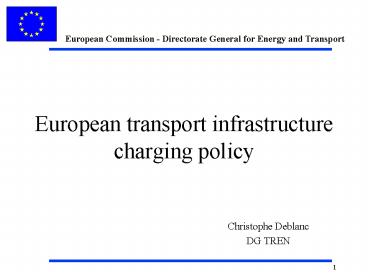European transport infrastructure charging policy - PowerPoint PPT Presentation
1 / 19
Title:
European transport infrastructure charging policy
Description:
Christophe Deblanc. DG TREN. 2. European Commission - Directorate General for Energy and Transport. Great variety in taxation systems (structures, levels, objectives, ... – PowerPoint PPT presentation
Number of Views:33
Avg rating:3.0/5.0
Title: European transport infrastructure charging policy
1
European transport infrastructure charging policy
- Christophe Deblanc
- DG TREN
2
The current situation
- Great variety in taxation systems (structures,
levels, objectives,) - Charges unrelated to the real costs of usage
- Low level of differentiation (e.g. pollution,
congestion) - Costs often borne by society.
3
The current situation
- Lack of consistency between modes
4
The current situation
- The current situation is muddled, inconsistent
and ineffective - need to cope with increased demand
- new investment needs
- limited public resources.
5
Principles of the EC charging policy
- Based on user-pays and polluter-pays
principles - External costs internalised
- infrastructure, congestion, accident,
environment - Ensure a more efficient and incentive-led
infrastructure use - Provide new financial resources
- Non discriminatory.
6
Major milestones in the policy process
7
Review of the current charging legislation
8
Road charging existing situation
Some countries considering moving to new
distance-related charging schemes
9
Road charging harmonised way forward
Revision of Eurovignette Directive proposed in
July 2003 (com(2003) 448 Final)
10
Outline of the Commissions proposalto revise
road charging legislation
- Modification of the scope for road charging
- Main road network TEN network Competing
roads - Lorries over 3.5 tonnes (instead of 12 t)
- Member States are free to apply tolls on
- Roads other than those of the main road network
- Small-sized lorries, private cars and other
vehicles - Charging principle
- Total infrastructure costs uncovered costs of
accidents - limited to recent infrastructures
- Special provision to take into consideration
existing concession contracts rights - Possibility for Member States to offset the
burden of a new charging system, notably by
reducing the annual vehicle tax.
11
Outline of the Commissions proposalto revise
the road charging directive
- Member States may vary the toll rates according
to - Vehicle type (road damage class and EURO emission
class) - Time of day (level of congestion)
- Member States must vary the toll rates (as of
2008) according to - Place ( environmental sensitivity and population
density) - Accident risk
- Possibility to apply mark-ups to tolls in
sensitive areas - for cross-financing infrastructures of a high EU
interest in the same corridor or transport zone - Maximum mark-up 25 of the average toll
- Subject to prior authorisation from the
Commission - The revenues must be used in the transport
sector - Member States must create monitoring independent
authorities.
12
Railway sector
Current legislation Directive 2001/14/EC on
the levying of charges for the use of railway
infrastructure
- A common charging principle charges shall be set
at the cost that is directly incurred - Exceptions (e.g. Mark-ups allowed to obtain full
recovery of costs) - External costs still optional
- Scarcity of capacity
- Environmental costs.
13
Aviation sector
- Proposal for a Directive (1997) on airport
charges - Mandatory cost related charging schemes (fixed
costs) - Modulation of charges in accordance with
environmental costs. - Abandoned
- Proposal for a Directive (2001) on airport noise
charges - Common method to calculate airport noise
charges - Modulation of noise charges remains optional.
- Current legislation
- Regulation in force on slot allocation
- No market based instrument to allocate capacity
so far.
14
Maritime sector
- Green Paper in 1997 on seaports and maritime
infrastructures - Marginal cost as a long term charging principle
- Careful implementation recommended.
- Some encouraging initiatives (e.g..
Differentiated fairway dues in Sweden).
15
The common infrastructure policy
16
Priorities for the trans-European network
17
Priorities for the trans-European network latest
proposal from the Commission
- Update of the priority projects 29 projects
identified - 600 B until 2020 for all TEN-T
- 220 B for the priority projects
- Provisions to ensure a better coordination and
better management of European interest projects
18
The financing rules
- General rule cofinancing up to 10 of total
cost - Specific cases
- 20 total costs for GALILEO
- 30 total costs for cross-borders priority
projects (safety, interoperability, modal shift,
removal of bottlenecks)
19
Conclusions
- Need to integrate sustainable mobility
requirements - Move toward more efficient use of the existing
networks - Strong role for charging in infrastructure
development - 40 B (out of 220) could be self-financed by
users - Emphasis on European interest corridor
- Cross-financing
- Increase of EU contribution.































